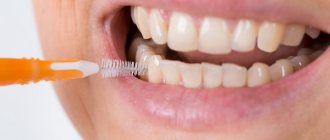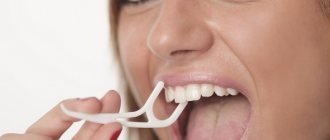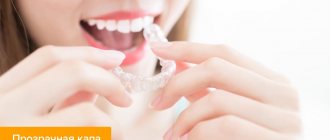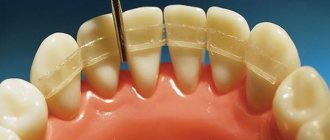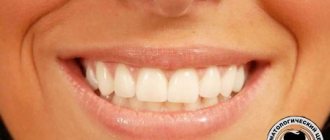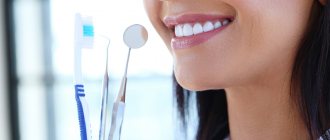Floss is a dental floss that allows you to clean teeth in hard-to-reach places and removes plaque from the surface. This is a hygiene aid and does not replace regular cleaning and rinsing of the mouth .
Using this product, you can eliminate the smallest food debris, thereby protecting the enamel from carious lesions.
Efficiency
Caries prevention is possible by brushing your teeth twice a day. The reproduction of bacteria is stopped, since they cannot live on a clean surface. However, the brush only copes with the internal and external areas. Meanwhile, food particles get stuck in the spaces between the teeth, where the bristles of the brush cannot penetrate.
As a result, pathogenic bacteria develop vigorous activity as food decomposes. The prerequisites for the formation of caries are created. The next stage is the appearance of carious cavities.
Use a thread to clean hard-to-reach areas. It is important to floss with a broken bite and with teeth located close to each other. It is partially possible to sanitize the cavities between the surface of the tooth and the gum - pockets. They are formed during periodontitis, and if you don’t take care of them, you can lose a tooth.
Functions of dental floss
Teeth and oral cavity need daily care. A person who radiates a snow-white smile and smells of fresh breath feels confident and attracts others. However, many people do not know all the intricacies of oral care. A regular toothbrush with paste or powder is not able to cope with food particles remaining in the interdental spaces. For this purpose, a special tool was invented - dental floss, which is also called floss.
Dental floss is a special thread for cleaning interdental spaces.
Manufacturers roll the long thread into a skein and package it in a plastic case. Thanks to this packaging, it is very easy to use: just unwind and cut a piece of the desired length. A standard package contains 50 meters of dental floss. The case protects the product from dust and dirt. It is small in size and fits easily into a pocket, which is very convenient. Floss is intended for daily use. However, in order for the care to be effective, you need to know how to use this device. Regular flossing helps:
- quickly and effectively remove food debris stuck between teeth;
- remove dental plaque;
- prevent the development of caries;
- keep your breath fresh all day.
Kinds
Flosses differ in the processing method:
- waxed;
- not waxed.
In the first case, the thread is covered with a thin layer of wax. This facilitates easy sliding and unhindered removal of deposits.
The “tool” is made from:
- silks;
- nylon;
- nylon;
- acetate.
Natural silk is rare. It was originally used when floss first appeared. Today, mostly artificial options are presented on pharmacy shelves.
The threads are made according to the shape:
- flat;
- round;
- tape
Dr. Zubastik advises purchasing the first ones for people with tightly spaced teeth, the second and third ones for those with wide gaps.
The floss subtype with the prefix “super” is intended for those who wear braces. This design consists of several parts. But we'll talk about it a little later.
Non-waxed threads can be used by those who have experience in cleaning the interdental space with floss. It is believed that they cope better with this task.
Waxed ones are convenient for beginners. The thread does not get stuck anywhere, glides freely, and does not split. There is no risk that a piece of it will remain between the teeth.
To increase the effect, floss is impregnated with therapeutic and prophylactic drugs. This:
- sodium fluoride (prevention of caries);
- chlorhexidine (disinfection);
- menthol (breath freshens).
You should choose a floss only after consulting a doctor, because when choosing it on your own, you may not take into account the peculiarities of the condition of your teeth and gums, as a result of which, instead of benefiting your health, you will cause harm to your health.
Types of dental floss
Flossing is not a new invention. In 1815, dentist Levi Farmley came to the conclusion that silk thread was an excellent tool for cleaning interdental spaces. Many years have passed since then, and modern manufacturers have come up with many types of floss, taking into account the anatomical features of the teeth and gums of different people. In order for the thread to effectively cope with its functions, it is necessary to choose it correctly. It is recommended to visit your dentist before using floss. He will conduct an examination, assess the condition of the patient’s teeth and gums, and then tell him whether he can use dental floss for daily oral care. There are many types of floss, which can be classified according to different criteria. Let's look at them in more detail.
By shape
- Rounded. This thread has a round cross-section and is suitable for wide interdental spaces.
- Flat. Designed for people whose teeth are located close to each other. Flat floss easily penetrates narrow spaces and cleans them.
- Tape. This thread is shaped like a tape and is intended for particularly wide interdental spaces.
The main purpose of floss is to thoroughly remove plaque and food debris from the spaces between teeth.
There is another variety - bulk thread. The dentist may recommend it to patients suffering from certain dental diseases. This floss swells under the influence of saliva, cleaning teeth well.
By processing method
- Waxed. This thread is coated with a thin layer of wax and is suitable for children and beginners who have never used this device before.
- Not waxed. This floss does not have a wax coating. It has good cleaning properties, perfectly removing plaque from the entire surface of the teeth.
By type of impregnation
- No impregnation. This is an ordinary floss that only cleans teeth and does not perform any additional functions.
- With impregnation. Some flosses are impregnated with special medications for greater effectiveness. Menthol extract perfectly refreshes the oral cavity. And fluoride impregnation is designed to protect teeth from caries, although according to doctors and patient reviews, threads impregnated with fluoride are not much more effective than regular ones.
Some types of floss have antiseptic impregnation, but such products should not be used by children. Adults can use them only from time to time, and not constantly.
By purpose
- For independent use. These varieties can be used by people wearing braces or dentures.
- For professional use. These flosses are used by dentists in clinics when they professionally clean patients’ teeth.
Flosses consist of polymer fibers, often nylon, connected by mechanical twisting and gluing. The thread may contain wax, saccharin, and flavorings.
By material type
- Silk. It is made from natural silk, but is very rare because it is fragile and impractical.
- Nylon. Nylon is an excellent material for the production of floss, since products made from it perform their function well and have a low cost, and therefore are inexpensive.
- Teflon. The material used to make dental floss is special Teflon fiber. Products made from them are very durable, high quality, but have a high cost, and therefore are not as popular among consumers as nylon.
If you are confused among such a variety and do not know which thread to choose, try several different options to evaluate the effectiveness and convenience of each of them. By testing different types of threads, you can choose the one most suitable for the anatomical features of your teeth and gums.
Use it correctly
There are 2 approaches to flossing teeth:
- Before carrying out the usual hygiene procedure using a brush and paste.
- After morning or evening cleansing is completed.
The first approach is closer to American dentists. They advise cleaning hard-to-reach areas before picking up a brush and starting the usual procedure. In Russia, doctors often recommend operations in the reverse order: brush your teeth, floss.
Regardless of what order you follow, the following rules are mandatory:
- Wash your hands.
- Cut a piece of floss 30-40 cm long.
- Take it so that part is wound around the middle finger of your right hand, and pinch part between the thumb, index and middle fingers of your left hand.
- Place the strip behind the tooth, trying to grab it, and move it up and down.
- Start with the upper jaw.
Remember : you cannot use one piece twice! If there is food or bacteria left on it, it can be transferred to the adjacent tooth. Inflammation will arise, and you will end up with what you were running away from: caries.
If there are no special recommendations from the dentist, then carry out the procedure once a day.
What if I have braces?
Regular oral care with floss is required.
Braces can become a source of infection if they are not cared for properly. Complete cleaning with a brush is not possible. The smallest particles - food debris and harmful bacteria - are located in the places of fastening.
Step 1
Step 2
Step 3
Step 4
To avoid this, make it a rule to keep dental floss in the bathroom and regularly do “spring cleaning.”
You will need waxed floss - they will not touch the elements of the system. The second, more reliable way is to buy superflosses. The difference is this: superfloss is made of three materials. There are:
- hard fiber;
- sponge fiber;
- synthetic thread.
The principle of use is the same as for a regular one, only the result is achieved faster.
Finally, superfloss
Examples of superfloss: Miradent or Oral-B. With braces in place, if you're just starting to master the art of flossing, also try Sensodyne Floss or Lacalut.
Popular brands
There are many companies that produce floss. Most often these are well-known brands that produce toothpastes, brushes, brushes and other devices for hygienic teeth cleaning.
Popular ones include the following manufacturers :
- Oral-B;
- SPLAT;
- Jordan Expand;
- ROCS;
- Colgate;
- Lacalut.
Dental floss from the manufacturer Oral-B (Oral bi satin floss) is one of the most popular.
They are quite durable and allow you to penetrate even the narrowest spaces between teeth. Available in skeins of 25 and 50 m. There is not only a standard thread, but also a variety with mint impregnation.
SPLAT company has several types: super thin with silver and waxed with different scents. All products from this manufacturer are impregnated with a special antibacterial agent.
Jordan Expand company produces bulky threads. Their advantage is that during use they delaminate, thereby cleaning more space. Such threads are impregnated with fluoride or mint-flavored toothpaste.
For your information! Jordan Expand flosses are not suitable for cleaning very narrow spaces between teeth.
Dental floss from ]ROCS[/anchor] has a mint impregnation. It is perfect for people with sensitive gums, as well as for patients with fluorosis. Such products do not contain fluorine.
Colgate flosses are used to prevent the formation of tartar. They are soaked in mint extract, so they freshen your breath well. Lacalut threads are coated with wax. They are recommended for use by those who have not yet encountered the use of floss. There are models with a cross section.
Crowns are not an obstacle
Many people are wary of advice to use floss if part of the teeth are covered with crowns. This fear is unfounded: such teeth also require careful care. The material that is placed between the crown and living tissue dissolves over time. Bacteria and plaque accumulate in these places. It must be cleaned off, because otherwise inflammation of the adjacent soft tissues is possible. This is fraught with the development of periodontitis.
We brush in the same way as usual, without distinguishing between “live” teeth and those covered with a crown. It is especially important to observe this rule in relation to metal ceramics. It is convenient to use superfloss.
Recommendations for children
Dental floss is recommended for adults. In childhood, use is not always advisable. Dentists do not recommend using it under 12 years of age because:
- the mucous membrane is delicate and easy to injure;
- not all milk teeth were replaced by permanent ones;
- The child’s movements can be sudden, which sometimes causes bleeding gums and inflammation.
After reaching the age of 12, and with the approval of the dentist, a teenager can floss their teeth. The first session should be conducted under parental supervision.
How to use floss
- Cut the thread to the required length.
- Wrap it around the index fingers and thumbs of both hands.
- Having pulled the thread, insert it into the interdental gap.
- Such manipulations must be done with each tooth.
After using dental floss, you should throw it away.
Toothbrush or floss
The natural question is: why do I need floss if I always brush my teeth twice a day with a modern brush, the manufacturer of which promises that it provides penetration into the “most difficult to reach places”?
Despite the improved shape of the brush, it is not able to achieve the degree of cleaning that the thread provides. The villi do not penetrate into the gaps between the teeth. This means that part of the plaque remains untouched.
At the same time, the brush is safer: if you carry out hygiene procedures 2–4 times a day, it is impossible to cause injury. Floss should not be used more than once a day.
Floss does not clean the front or back surfaces. Therefore, these hygiene items are not interchangeable. They complement each other.
special instructions
Like any therapeutic and prophylactic method, the process of flossing teeth has contraindications. Avoid this oral care method if you have:
- caries has been diagnosed and not yet healed (pieces of teeth affected by microbes break off);
- gums bleed;
- Many crowns, bridges and implants have been installed.
The last case is a relative contraindication. Doctors allow and even recommend dental floss, but only after a thorough examination of the oral cavity. Old crowns and bridges are replaced and approval is given for the purchase of floss.
How to choose?
The choice of manufacturer and specific type of product should be based on the condition of the teeth , as well as the individual structure of the dentition . It is best for a doctor to select such a product.
If there are no dental diseases and the teeth are not closely spaced, it is recommended to use non-waxed dental floss with a round cross-section .
The type of impregnation can be any depending on individual preferences. For twisted teeth , as well as during the inflammatory process, floss in the form of tapes with bactericidal impregnation can be used .
Waxed is perfect for cleaning narrow spaces. Due to its coating, it will easily pass between the teeth. To clean teeth with weakened enamel or initial carious lesions, it is recommended to use threads impregnated with fluoride preparations .
Advice from Dr. Zubastik
Strips or threads are a universal remedy for maintaining healthy teeth and gums. Therefore, use them along with a brush. But follow your dentist's recommendations. So, let me remind you:
- Brush your teeth carefully! Excessive force can cause wounds and microtrauma to the gums.
- If you do touch the gum and see blood, stop the procedure and rinse your mouth with warm, salty water. Do not floss until the tissue is completely healed.
- Once a day is enough. Don't go overboard with your desire for cleanliness.
- Get your children used to flossing and tell them in advance about the benefits of the hygiene product.
- If there are contraindications, visit your dentist for advice. You may be allowed to buy floss after treatment.
Useful video:
Don't forget the main thing: oral care should be regular! Only then will it guarantee the absence of pathologies. Take care of your teeth and gums, and they will remain healthy until old age.
Tags: dental floss, floss, teeth cleaning
About the author: Dr. Zubastik
Typically, a toothache begins to subside on the way to the clinic and finally goes away after 10 minutes of sitting in line to see the dentist.
- Related Posts
- How does ultrasound remove tartar?
- 5 home care products for braces
- Gently care for your teeth with cleansing foam
« Previous entry




